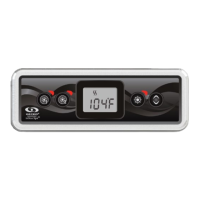If you sense any of the symptoms of hyperthermia, safely exit the hot tub immediately.
Cautions
• Observe a reasonable time limit when using the hot tub. Long exposures at higher temper-
atures can cause high body temperature. Symptoms may include dizziness, nausea, faint-
ing, drowsiness, and reduced awareness. These e!ects could possibly result in drowning.
• Always test the hot tub water temperature before entering the hot tub. Enter and exit the
hot tub slowly. Wet surfaces can be very slippery.
• Proper chemical maintenance of hot tub water is necessary to maintain safe water and pre-
vent possible damage to hot tub components.
• Use the straps and clip tie downs to secure the cover when not in use. This will help to dis-
courage unsupervised children from entering the hot tub and keep the hot tub cover secure
in high-wind conditions. There is no representation that the cover, clip tie-downs, or actual
locks will prevent access to the hot tub.
• For exercise, the water should not exceed 90 °F (32 °C).
• Maintain water chemistry in accordance with manufacturer’s instructions.
Set-Up And Delivery Guidelines
Location
Some Points to Consider:
• How close is the spa from the exit or entrance to your house? (Consider the cold
weather)
• Is the path to the spa clean of debris, sand, grass clippings? (So as not to track into
spa)
• Is there any protection from wind, inclement weather?
• Can neighbors or passersby see the spa?
• If your spa is to be placed near where sprinklers may hit the cabinet, shell or equip-
ment, please adjust or cap them to prevent prolonged water exposure.
• Generally, spas belong outdoors. Locating a spa indoors increases your risk of indoor
flooding.
Outdoor Installations:
• Local electrical and plumbing codes.
• Consider local codes pertaining to fencing, enclosures, walls, electrical and plumbing. You
will need to ensure that your spa is an adequate distance from power lines, both above
ground and underground. Your spa will also need to be childproofed (covered and of ade-
quate height).
• View from house for aesthetics and supervisory needs.
• Distance from house for wintertime soaking.
• Nighttime lighting.
• Locate the spa with an awareness to sunlight exposure, views, access, lot lines, lighting,
wind direction, shielding, septic tanks, plants, trees. (Chemicals in the spa water splashed
from within your spa may damage plant life.)
• Consider the location of the nearest bathroom.
• If your spa is to be located on a second story, be positive support is adequate."
• Area for placement of support equipment where adequate space will be needed for periodic
removing and cleansing of the cartridge filter and general servicing.

